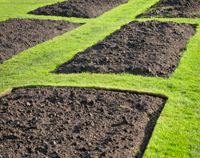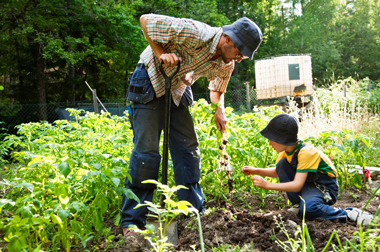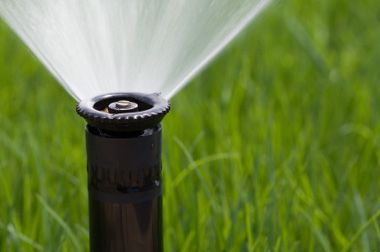Site Preparation
Site Preparation

Good site preparation is essential to creating a water efficient landscape. It can save time and money and help to create a landscape that will provide you with years of enjoyment. Site preparation entails assessing existing elements of the current landscape, developing a design and plan, good site and soil preparation, and installing efficient irrigation.
Assessing the Current Landscape
You may start with bare ground or you may have an existing landscape that you want to make more water efficient. As you start to develop a plan for your new landscape, walk around your yard and make notes of what is already there. Even a high water use plant can be kept in a well-designed xeriscape as long as it receives supplemental water from roof run-off or other sources and isn’t located in full sun.
The watering requirements of the plants and various climatic conditions within the landscape (known as micro-climates) should also be considered when deciding on the placement of turf areas, gardens, trees and shrub borders. It may be helpful to take pictures of your landscape from several different angles. Take notes as you view your yard at different times of the day and at different times of the year and ask the following questions:

- What are the existing features of the landscape?
- Trees or shrubs that require a long time to grow or would be difficult to replace
- Patios, walkways, structures
- Views that need to be preserved
- Low or high spots, slopes that may be difficult to irrigate efficiently
- Utility boxes, overhead power lines, easements, right of ways
- What elements of the landscape do you want to keep?
- Large trees
- Grandpa's prize rose bushes
- A lawn where the kids can play
- The sandbox or kids play area
- The dog run
- A clothes line
- What do you want to eliminate?
- The overgrown junipers that block the morning sun
- Narrow strips of turf that are difficult to water efficiently
- The wooden deck that requires staining every year
You may be able to answer these questions on your own or you may prefer to have the assistance of a professional. Professionals can guide you through the preliminary process of evaluating your current landscape and offer a number of different design options. It is certainly possible to develop and implement a good landscape design without the aid of a professional, however. The next step is to begin planning and designing your landscape.
Plan and Design
A good design is essential. The design should be suited for the site and its characteristics and should consider factors such as the slope, soil type, topography and intended use of the site. Each element of the design should be carefully considered not only for its aesthetic benefits but also for its contribution to water and energy efficiency. A large deciduous tree, for example, when placed on the southwest corner of the home, can provide cooling of the house and yard in the summer while allowing solar radiation to warm the house during the winter months. A mixed shrub border provides year-round visual interest as well as a screen for wind or unsightly views. Water-wise gardens can provide a riot of color all summer long while using much less water than a similar area covered in turf.
Planning and designing your landscape requires the answer to several questions.

- How much can I afford to spend on landscaping?
- For a professional landscape designer?
- For some or all of the labor?
- For plants?
- What purpose(s) will the landscape serve?
- Turf area for play?
- Deck area for entertaining?
- An herb or vegetable garden for cooking?
- Screening an unsightly view?
- How much of the work can I do myself?
- Can I install the landscaping in stages?
- Over a season?
- A year?
- Several years?
- How much time am I willing to spend on maintenance?
- Mowing?
- Weeding?
- Watering?
- Pruning?
- How much water am I trying to save?
- Willing to water high water-use plants (turf)
- Willing to water occasionally
- No supplemental water after landscape is established
Once these questions have been answered it is important to sketch the major elements of the landscape, including existing elements and any proposed changes. A scale drawing will help you to visualize important elements of the landscape and will help to prevent errors that can occur when trying to "eyeball" how much space is available for a shrub border, a shade tree, or a patio for example. The tendency in many landscapes is to overplant and to ignore the ultimate size of the plants. Even professional landscapers sometimes make the mistake of over-planting in order to give the landscape a finished appearance. This can result in an over-crowded landscape and higher maintenance costs.
While the goal of a good landscape design is to provide a design that will be pleasing for years to come, landscapes are not static. Keep all landscape and irrigation design plans so that they can be referred to at a later date if changes, updates, or repairs need to be made.
Preparation for Planting

A key element of a water efficient landscape design is the separation of planting areas into individually irrigated zones known as hydrozones. The soil and climate characteristics should be similar throughout the hydrozone. It should not consist of an area where part of the zone receives sun all day and contains clay soil with no organic soil amendments while the rest of the zone is in shade for part of the day and is amended with plenty of organic soil amendments or is a very different soil type like sandy loam.
Call water and electric utilities, and the cable company to mark the location of existing lines – including depth. Make sure to consider overhead spaces when planting trees. Pruning trees to prevent interference with power lines is expensive, potentially dangerous, and compromise both the health and aesthetics of the tree.
Remove weeds from areas to be planted to prevent competition for water, light and nutrients. Effective weed control when the landscape is being established will result in less maintenance later on.
Evaluate areas on the site where landscape material such as mulch, topsoil, and soil amendments can be stored. Any topsoil that is removed during the landscape process should be stored on site and replaced as needed.
Reduce traffic of heavy equipment to the extent possible so as to reduce compaction of soil. Compaction reduces the space between soil particles thereby reducing the amount of air and water available to the plants. Wet soil is especially vulnerable to compaction. Avoid watering the landscape prior to use of heavy equipment.
Prepare planting holes for trees and shrubs BEFORE they are delivered. Trees and shrubs are often supplied in black plastic tubs or balled and burlapped which makes them susceptible to drying out and heat stress. Getting them planted quickly minimizes the stress to the plant and reduces the time spent watering them. If immediate planting isn’t feasible place plants in a shady area and keep the root ball moist.
Keep in mind that some plants suffer when planted at certain times of year. Pay attention to this factor especially on the larger, more valuable specimens you select.
Efficient Irrigation

In short, efficient irrigation means providing plants with the water that they need when they need it. Irrigation is used to supplement the water needed by the landscape to survive when native precipitation is inadequate. Plants will need additional water when they are first being established and their root system is small and shallow, and during prolonged periods of windy, dry, or hot weather.
Overhead irrigation with sprayheads and rotors is generally less efficient than drip irrigation. The use of overhead irrigation should be limited to turf areas; all other areas of the landscape should be irrigated with drip. Drip irrigation should be installed only around the root zone of the plants to be irrigated. It should be designed to "grow" with the plant. As the plants get larger the root zone increases and the drip emitters should be moved to the edge of the root zone.
Overhead irrigation is typically installed underground and used to irrigate turf area; trenches should dug before turf is planted and any deviation from the original irrigation design noted. This will help to avoid damage to irrigation equipment that can result in costly repairs.

